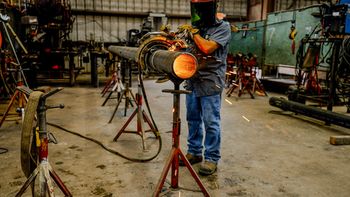
Streamlining the Lube Oil System
TRANSFER BARRIER ACCUMULATORS CAN SLIM DOWN YOUR LUBE OIL SKID AND PROTECT THE ENVIRONMENT
BY JOE CHEEMA
Lube oil systems provide lubrication and cooling to gas turbines and other industrial equipment. In turbomachinery, they are important for hydrodynamic bearing performance. The system assists in dissipating or settling contaminants, providing for temperature fluctuations and storing oil.
One of the main causes of lube oil system failure is loss of lubricant flow. This can lead to excessive wear and premature replacement of bearings. Accumulators act as a safeguard against such failures by providing a temporary supply of lube oil in the event of flow disruptions, thereby preventing a pressure drop during a power outage or a switchover between oil pumps.
Accumulators also help maintain a constant oil pressure during temporary changes in demand. Lube oil systems for turbomachinery consist of three elements: a high flow-rate pump, a reservoir and an accumulator.
Lube Oil System Accumulators (LOSA) prevent bearing damage and increase bearing life by supplying oil to the bearings when a power failure shuts down the pump, or when changing between the primary
and backup oil pump.
An accumulator is a pressure vessel that stores oil and contains a mechanical means of maintaining pressure when the pump shuts down, thus cushioning fluctuations in oils pressure. Accumulators differ on the type of mechanical means used, such as spring, gravity and gas load.
Spring accumulators use a spring-loaded position in a cylinder. As the oil line pressure increases, more oil flows into
the cylinder and compresses the spring, with the spring pressure matching the hydraulic pressure.
Then, when the pressure drops, the spring forces the oil back out of the cylinder into the system. This kind of accumulator has limited use in high-cycle applications, as the spring fatigues and loses its elasticity. In addition, they struggle to maintain a constant pressure.
Gravity-loaded accumulators use weights to drive a piston and provide the desired pressure. While these accumulators achieve near constant pressure, they are larger, heavier and more costly than other types. Gas-loaded accumulators, on the other hand, use compressed gas to provide the necessary pressure. They can be divided into two main categories: separator and non-separator accumulators.
Non-separator accumulators do not have any barrier between the gas and the liquid. While this is the simplest design and can store the greatest amount of oil, the downside of non-separator accumulators is that the f luid may absorb gas at high pressures, since there is no barrier separating gas from oil. As pressure drops, the absorbed gas forms bubbles in the oil, which may cause foaming in the oil resulting in damage to many components of the system.
The better approach for LOSA applications is to use a barrier between the gas and the fluid, such as a rubber bladder. This is where the second type of gas-loaded accumulator comes in—the bladder-type. It consists of a metal cylinder containing a pressurized bladder.
In accordance with API standards, these accumulators are made of 300 series stainless steel and can withstand maximum pressures of about 1,500 psi. Because of its high flexibility and low weight, the bladder has a rapid response time, allowing the accumulator to quickly compensate for pressure drops in the system and prevent
damage to the bearings and other components. This kind of accumulator forms the basis for the transfer barrier accumulator.
Slimming Down the Skid
Due to the volume of oil and the required amount of flow, lube oil skids often accommodate multiple gas-loaded accumulators to contain enough standby oil to keep the system functioning. To enable the lube oil system to feed oil at rates of 400-500 gallons per minute, for example, at least 100 gallons of oil must be stored under high pressure. That may require 8 or 10 accumulators tied together to provide the necessary volume
of oil.
A better solution is to use one or two large transfer barrier accumulators on a lube oil skid to perform the same function. As well as serving as part of a lube oil skid for a turbine, transfer barrier accumulators can be used with turboexpanders and compressors.
A further use is for storage of discarded fluids—once the tank is full, these fluids can be pumped out. For example,
this kind of accumulator is currently used for sub-sea drilling of oil. Once the accumulator fills up with discarded fluids, they can be pumped to the ocean surface for safe environmental disposal.
Further, transfer barrier accumulators are used in applications where two fluids must transfer pressure without mixing the fluids together. For example, water would be used on the inside and oil on the outside of the bladder, or alternatively clean oil would be on one side and dirty oil on the other. Transfer Barrier accumulators
can also be used to cycle different pressurized fluids in and out of chambers.
Their design enables them to deal with two different types of fluid and to transfer pressure and a small amount of
volume from one medium to another. As such, these accumulators can be used as a substitute for a hydraulic pump for transferring or transmitting fluids, with the bladder being operated as a piston to let a fluid flow into and out of the accumulator intermittently.
The transfer barrier accumulator has a gas bottle on the side which allows the gas to be removed from inside the accumulator via an opening at the top of the bottle. When a backup gas bottle is included, the transfer barrier accumulator can supply a large volume of fluid even when the system pressure difference is low.
Yet another application is known as the B-type transfer barrier accumulator. It is used to transmit pressure between dissimilar fluids. A tube inserted into the bladder has many holes. This prevents fluid from attacking one spot of the bladder inner wall and protects the bladder from damage.
Joe Cheema is General Manager at Fluid Energy Controls, a provider of accumulators and fluid power products. For
more information, visit fecintl.com or call Tel: 323-721-0588
Newsletter
Power your knowledge with the latest in turbine technology, engineering advances, and energy solutions—subscribe to Turbomachinery International today.




